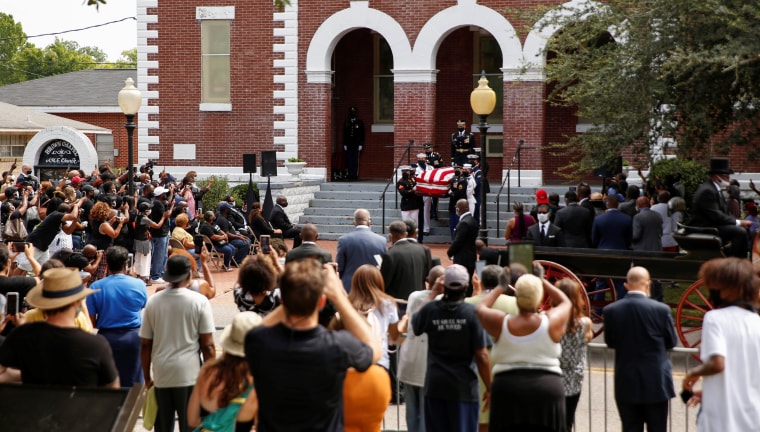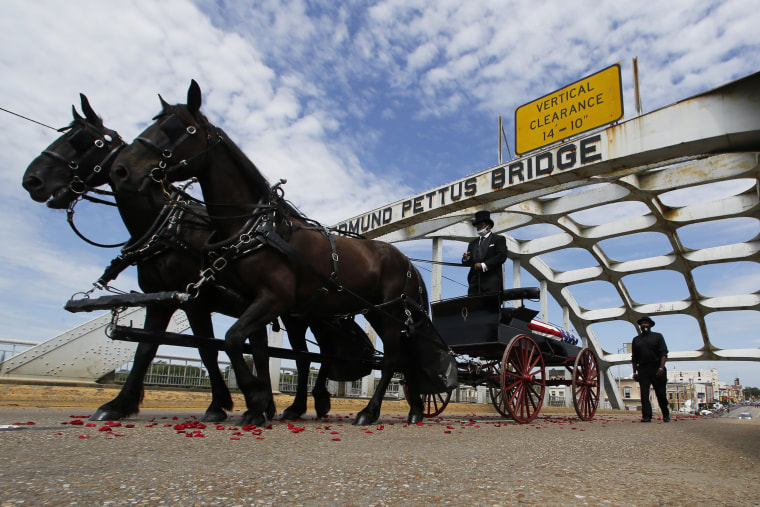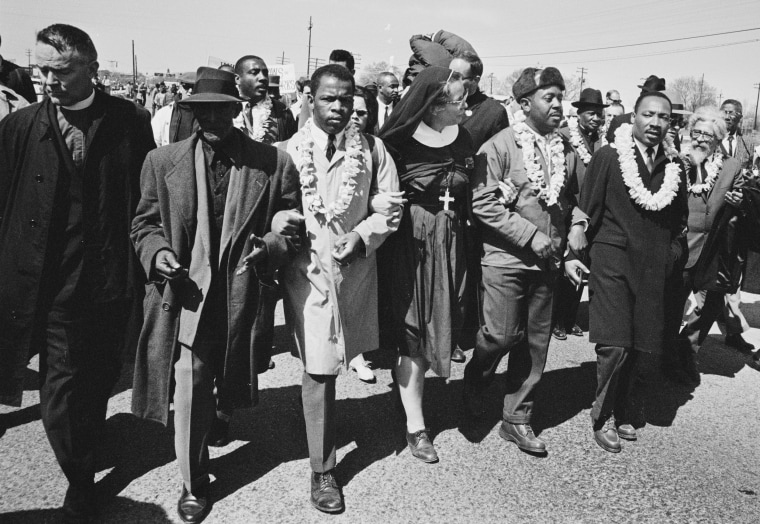Crowds watched solemnly Sunday as the body of Rep. John Lewis crossed the Edmund Pettus Bridge one final time, 55 years after the civil rights icon marched for peace and was met with brutality in Selma, Alabama.
Body bearers from the U.S. armed forces placed the late Georgia congressman and civil rights icon onto a horse-drawn caisson Sunday at the Brown Chapel African Methodist Episcopal Church. From there, the public was allowed to line up to honor Lewis for about a half-mile to the foot of the bridge.
Rep. Terri Sewell, D-Ala., thanked Lewis’ family during a ceremony at the chapel for sharing the congressman with the public for so many years.
“Our nation is better off because of John Robert Lewis,” she remarked. “My life is better, Selma is better, this nation and this world is better because of John Robert Lewis.”

Crowds waited for Lewis’ body at the foot of the bridge, where he was met by Alabama state troopers, who safely escorted him on to the state Capitol.
"His final march, that final crossing, so different than the first, speaks to the legacy that he leaves behind and the lives that he changed," Sewell said. "It’s poetic justice that this time, Alabama state troopers will see John to his safety."
As the horse-drawn caisson approached the bridge, the crowds on the sidewalk could be heard singing for Lewis. In an emotional moment, the voices stopped as Lewis' casket began to make its way across the bridge in silent reverence.
Lewis, who died on July 17 at the age of 80, made his last journey across the bridge with only his family to join him.
Lewis' son, brothers and sister followed behind the caisson along with Lewis' longtime chief of staff, wearing shirts emblazoned with the words "Good Trouble," a nod to Lewis' view on activism.
Hours later, Lewis arrived to lie in state in Alabama's Capitol in Montgomery, where mourners lined up around the block to pay respects.

The lawmaker, who died in his 17th term and was often called the "conscience of Congress," was a giant of the civil rights movement of the 1960s. Lewis was only 25 when, he said, he believed Alabama troopers would kill him on the peaceful march for voting rights across the bridge on March 7, 1965, which became known as “Bloody Sunday.”
Lewis suffered a fractured skull and was one of dozens of nonviolent protesters who were hospitalized. News coverage of the brutal beatings prompted increased pressure on Congress to pass the 1965 Voting Rights Act, barring states from enforcing discriminatory laws that had long hindered prospective Black voters.
Though Lewis is possibly best known for his march in Selma, he had already emerged as a leading voice in the fight for equal rights and had been arrested a number of times for the cause by then.

As a student at Fisk University in Tennessee, Lewis helped organize sit-ins at segregated lunch counters. He was one of the original Freedom Riders in 1961, taking buses from the North to the Deep South to protest segregation at interstate bus terminals.
At 23, Lewis was the youngest person who spoke at the 1963 March on Washington for Jobs and Freedom. He was chairman of the Student Nonviolent Coordinating Committee at the time.
Calls have grown to rename the Edmund Pettus Bridge after Lewis, to honor the man who was arguably a lion in the fight for equality. A petition began in June by political strategist Michael Starr Hopkins, who told NBC News at the time that the idea came to him while watching Ava DuVernay’s “Selma” following days of protesting.
But Lewis’ death amplified the call to rename the bridge, which currently honors a Confederate general and KKK leader.
Selma officials, however, oppose the name change, according to the Associated Press. Alabama state Rep. Prince Chestnut, whose legislative district includes Selma, said it would be inappropriate to rename the bridge for Lewis alone.
“There were many Selmians and Alabamians who were either on the bridge in March 1965, near the vicinity or precipitated the situation that changed this country for the better. John was not the only one,” Chestnut said in a statement to the Associated Press.

Chestnut said he’d favor calling it something more general, such as the “Bloody Sunday Bridge” or “Historic Selma Bridge,” rather than naming it for Lewis.
But Rep. Jim Clyburn, D-S.C., told NBC's "Meet the Press" after Lewis' death that the Georgia congressman had made unmatched sacrifices for the civil rights cause.
"Take his name off that bridge," Clyburn said, referring to Pettus, "and replace it with a good man — John Lewis, the personification of the goodness of America — rather than honor someone who disrespected individual freedoms."
CORRECTION (July 27, 8:40 a.m. ET): A previous version of this article misstated the station that Rep. Jim Clyburn spoke to after John Lewis' death. It was NBC, on "Meet the Press," not MSNBC.